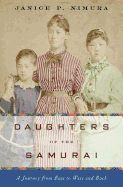
In Daughters of the Samurai: A Journey from East to West and Back, Janice P. Nimura tells the story of three young girls, ages 11, 10 and six, whom the Japanese government sent to the United States in 1871, as part of the Westernizing reforms of the Meiji Restoration that transformed Japan in the mid-19th century. The idea was that when they returned to Japan they could teach a generation of Japanese women how to raise enlightened sons.
The experiment was set in motion with remarkably little planning. Nominated by their parents with an eye toward political and economic benefits for their families, all of the girls were scarred, one of them literally, by the recent civil war that had overthrown the shogun and destroyed the power of the samurai class. They spoke no English and had a chaperone who didn't speak Japanese. They were on the boat for two days before someone arranged for them to get regular meals.
Nimura brings skillful storytelling and a high degree of cross-cultural awareness to her account of the girls' successful (and often joyous) adaptation to a new culture, their difficulties re-adapting to their own culture when they returned 10 years later, and how the long-term relationships they formed in the United States shaped women's education in Japan.
Daughters of the Samurai is an engaging work of women's history set in a moment when the status of women was changing in both Japan and the United States. --Pamela Toler, blogging at History in the Margins

